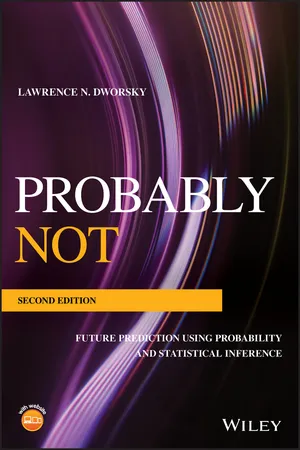
Probably Not
Future Prediction Using Probability and Statistical Inference
- English
- ePUB (mobile friendly)
- Available on iOS & Android
About This Book
A revised edition that explores random numbers, probability, and statistical inference at an introductory mathematical level
Written in an engaging and entertaining manner, the revised and updated second edition of Probably Not continues to offer an informative guide to probability and prediction. The expanded second edition contains problem and solution sets. In addition, the book's illustrative examples reveal how we are living in a statistical world, what we can expect, what we really know based upon the information at hand and explains when we only think we know something.
The author introduces the principles of probability and explains probability distribution functions. The book covers combined and conditional probabilities and contains a new section on Bayes Theorem and Bayesian Statistics, which features some simple examples including the Presecutor's Paradox, and Bayesian vs. Frequentist thinking about statistics. New to this edition is a chapter on Benford's Law that explores measuring the compliance and financial fraud detection using Benford's Law. This book:
- Contains relevant mathematics and examples that demonstrate how to use the concepts presented
- Features a new chapter on Benford's Law that explains why we find Benford's law upheld in so many, but not all, natural situations
- Presents updated Life insurance tables
- Contains updates on the Gantt Chart example that further develops the discussion of random events
- Offers a companion site featuring solutions to the problem sets within the book
Written for mathematics and statistics students and professionals, the updated edition of Probably Not: Future Prediction Using Probability and Statistical Inference, Second Edition combines the mathematics of probability with real-world examples.
LAWRENCE N. DWORSKY, PhD, is a retired Vice President of the Technical Staff and Director of Motorola's Components Research Laboratory in Schaumburg, Illinois, USA. He is the author of Introduction to Numerical Electrostatics Using MATLAB from Wiley.
Frequently asked questions
Information
1
An Introduction to Probability
Predicting the Future
Table of contents
- Cover
- Table of Contents
- Acknowledgments
- About the Companion Website
- Introduction
- 1 An Introduction to Probability
- 2 Probability Distribution Functionsand Some Math Basics
- 3 Building a Bell
- 4 Random Walks
- 5 Life Insurance
- 6 The Binomial Theorem
- 7 Pseudorandom Numbers and Monte Carlo Simulations
- 8 Some Gambling Games in Detail
- 9 Scheduling and Waiting
- 10 Combined and Conditional Probabilities
- 11 Bayesian Statistics
- 12 Estimation Problems
- 13 Two Paradoxes
- 14 Benford's Law
- 15 Networks, Infectious Diseases, and Chain Letters
- 16 Introduction to Frequentist Statistical Inference
- 17 Statistical Mechanics and Thermodynamics
- 18 Chaos and Quanta
- Appendix
- Index
- End User License Agreement